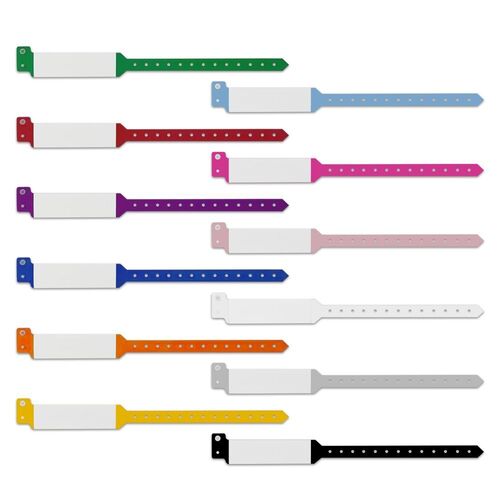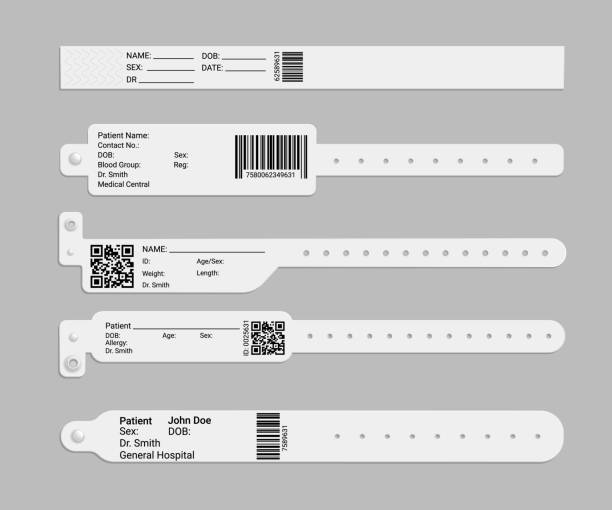The Impact of a Patient Identification Band in Improving Hospital Patient Tracking Systems
Wiki Article
A Comprehensive Overview to Patient Identification Band as a Vital Medical Supply
In the substantial landscape of healthcare, Patient Identification bands have arised as an essential tool (patient identification band). These bands, teeming with necessary data, function as the very first line of protection against clinical errors and ensure smooth Patient treatment. As we begin to check out these clinical supplies comprehensive, we uncover the intricacies of their style, use, and effect on Patient safety, while hinting at the pledge they hold for future medical practicesThe Duty of Patient Identification Bands in Health Care
The relevance of Patient Identification bands in health care can not be overstated. These straightforward wristbands act as the primary approach of ensuring Patient identity, reducing the risk of clinical mistakes and improving general Patient safety and security. They are a crucial tool in validating a patient's identification before carrying out therapies, medications, or conducting treatments. They are often color-coded to denote various health conditions, allergic reactions, or threat factors, permitting fast aesthetic Identification by medical care specialists. In the fast-paced, high-pressure globe of health care, where human lives go to stake, the benefits of such an easy yet effective tool are invaluable. Patient Identification bands supply a system of balances and checks, a fail-safe versus possible errors, and a continuous suggestion of the individual behind the treatment.Deciphering the Details on Patient Identification Bands
While they might seem straightforward at a glimpse, Patient Identification bands bring essential details that can greatly impact the training course of a person's care. These bands typically display the Patient's name, day of birth, and an unique identifier, such as a medical record number. In addition, the barcode found on these bands can be checked to access the Patient's digital health and wellness document, giving a riches of information to medical care service providers.Different Kinds Of Patient Identification Bands: A Closer Look
In the world of Patient Identification, there are several kinds of bands that offer unique purposes. Barcode Identification Bands, RFID Tag-based Bands, and Color-Coded Patient Bands are the key categories - patient identification band. Each type presents one-of-a-kind attributes and advantages, which will certainly be analyzed in the following sectionsBarcode Identification Bands
Offering a considerable improvement in Patient security, barcode Identification bands have actually come to be an essential instrument in the clinical field. These bands shop critical Patient data in a barcode layout that's quickly easily accessible with a check. Notably, these bands have significantly lowered medical errors and boosted Patient safety.RFID Tag-based Bands
One more innovative strategy in Patient Identification is the usage of RFID Tag-based bands. These bands use Radio Frequency Identification (RFID) modern technology to supply a protected type of Patient Identification. Despite these obstacles, RFID tags use considerable potential for improving Patient safety and security and performance in health care.Color-Coded Patient Bands
Color-coded Patient bands stand as an easy yet effective device in Patient Identification. These bands, prevalent in clinics and hospitals, utilize different colors to show different Patient problems, threats or allergies, making certain instant acknowledgment by medical care specialists. A red band typically symbolizes an allergic reaction, while yellow shows a fall threat. These bands are made to be easily noticeable and distinct, also in high-stress circumstances. This instant visual hint permits punctual, accurate care, minimizing the potential for clinical mistakes. It's crucial that team are thoroughly trained in the color definitions, as complication can lead to severe effects. Therefore, the color-coded Patient band system is an important part of Patient security and effective medical care distribution.
Use of Patient Identification Bands: Procedures and procedures
In medical care settings, the use of Patient Identification bands plays a critical duty in ensuring Patient security and minimizing medical mistakes. These bands, generally made of sturdy, hypoallergenic material, are attached to the Patient's wrist or ankle joint, presenting crucial details such as name, date of birth, and a special identifier. The procedure is typically carried out during admission, with the details double-checked for accuracy. For babies, bands are connected to both the baby and mother to avoid inequalities. In senior care, two see here bands might be made use of for individuals with mental deterioration to make sure proper Identification. Following these methods assists to prevent Patient misidentification, a forerunner to major clinical mistakes. This method is a testament to the essential nature of Identification bands in Patient care.The Impact of Identification Bands on Patient Safety And Security
Identification bands play a crucial function in maintaining Patient security in medical care settings. Their usage can considerably minimize clinical errors by guaranteeing that the ideal Patient gets the proper treatment. Moreover, these basic tools add to enhancing the top quality of treatment by giving an additional layer of verification to Patient identities.
Decreasing Clinical Mistakes
A shocking variety of clinical mistakes, approximated to be in the thousands of thousands each year, can be mapped back to misidentification of people. These mistakes lead not only to hurt to the Patient yet additionally lead to expensive lawful and reputational problems to the medical care establishment. Patient Identification bands have emerged as an invaluable tool in substantially lowering these mistakes. They supply a basic, yet effective, technique of properly recognizing patients. Crucially, these bands ensure that every Patient is appropriately matched with their medical records, tests, and treatments, thereby considerably minimizing the danger of medical errors. By ensuring accurate Patient Identification, these bands add to improved Patient safety, building trust and self-confidence in the medical care system.Ensuring Appropriate Therapy
Protecting Patient safety and security, Identification bands play a critical role in making certain the correct administration of therapies. They provide a straightforward yet effective method for appropriately identifying patients and matching them to their clinical records. This lowers the risk of therapy mistakes, especially in high-pressure situations where errors can have extreme repercussions. These bands contain vital info such as the Patient's name, date of birth, and one-of-a-kind Identification number. Consequently, they assist in exact cross-referencing with electronic wellness documents, prescription orders, and procedural routines. Therefore, the possibility of misdiagnosis, drug mistakes, or procedural mix-ups is drastically minimized. Fundamentally, Patient Identification bands serve as an important secure in the medical care setting, dramatically adding to Patient security and making certain appropriate therapy.
Enhancing Quality Treatment
While they might appear irrelevant, patient Identification bands substantially boost the quality of treatment supplied in healthcare settings. They are an essential device in guaranteeing Patient security due to their capability to offer immediate access to important details. The fostering of Patient Identification bands is, for that reason, an essential measure in all medical care click to read settings.Exploring the Future of Patient Identification Bands in Medical Method

Conclusion
Patient Identification bands play an essential duty in healthcare, making certain accurate Patient Identification and reducing clinical mistakes. These important tools raise safety and security and provide instant accessibility to critical wellness data. The combination of biometric and digital modern technologies can even more enhance Patient safety and security, care high quality, and personal privacy. As medical methods proceed to develop, Patient click here to find out more Identification bands will certainly remain a critical part of the healthcare system.While they might appear basic at a look, Patient Identification bands carry vital information that can considerably affect the course of a client's care.Color-coded Patient bands stand as an easy yet efficient device in Patient Identification.In medical care setups, the use of Patient Identification bands plays a pivotal role in making certain Patient safety and security and lowering clinical mistakes. In significance, Patient Identification bands offer as a crucial protect in the healthcare setup, dramatically contributing to Patient safety and security and making certain correct treatment.
Patient Identification bands play an essential role in healthcare, making certain precise Patient Identification and reducing clinical mistakes.
Report this wiki page